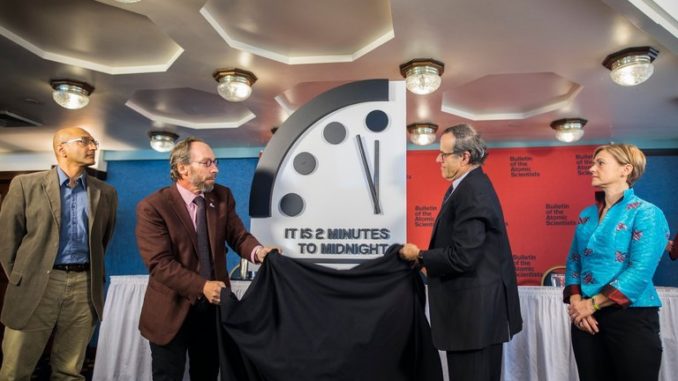
JAN. 25, 2018
The Doomsday Clock, a potent symbol of scientific concerns about humanity’s possible annihilation, was advanced by 30 seconds on Thursday, to 2 minutes to midnight, the Bulletin of the Atomic Scientists announced in Washington.
The last time the clock was moved so close to midnight was in 1953, during the Cold War.
“In 2017, world leaders failed to respond effectively to the looming threats of nuclear war and climate change, making the world security situation more dangerous than it was a year ago — and as dangerous as it has been since World War II,” the bulletin’s science and security board, which oversees the clock, said in a statement.
It cited the risks from North Korea’s nuclear program; discord between Russia and the United States; tensions in the South China Sea; the buildup of the nuclear arsenals of Pakistan and India; and uncertainty over the Iran nuclear deal.
The scientists also warned that the sustained reductions in greenhouse gases needed to prevent disastrous warming of the planet had not yet occurred and cited the dangers that technology disruption is causing for democracies, including disinformation campaigns intended to manipulate elections and undermine confidence in democracy.
They also found that “in 2017, the United States backed away from its longstanding leadership role in the world, reducing its commitment to seek common ground and undermining the overall effort toward solving pressing global governance challenges.”
The scientists cited, among other destabilizing factors, the harsh rhetoric President Trump has exchanged with North Korea’s leader, Kim Jong-un; Mr. Trump’s disavowal of the Iran deal; the hiring of climate-change deniers at the Environmental Protection Agency; and the administration’s plans to remake and expand the nation’s nuclear arsenal.
“Neither allies nor adversaries have been able to reliably predict U.S. actions — or understand when U.S. pronouncements are real, and when they are mere rhetoric,” the scientists found. “International diplomacy has been reduced to name-calling, giving it a surreal sense of unreality that makes the world security situation ever more threatening.”
The scientists added: “To call the world nuclear situation dire is to understate the danger — and its immediacy.”
The clock was last set at 2 minutes to midnight in 1953, after the Americans and then the Soviets tested thermonuclear weapons for the first time, within six months of each other. That was also the year that the Korean War ended — or, some would argue, paused — and President Dwight D. Eisenhower unveiled Atoms for Peace, a program intended to convince Americans that nuclear energy could be used to support research, medicine and agriculture and not only to destroy.
That year, Eugene Rabinowitch, a former Manhattan Project scientist who co-founded the bulletin, wrote: “The achievement of a thermonuclear explosion by the Soviet Union, following on the heels of the development of ‘thermonuclear devices’ in America, means that the time, dreaded by scientists since 1945, when each major nation will hold the power of destroying, at will, the urban civilization of any other nation, is close at hand.”
The clock has been adjusted many times since it debuted in 1947. Since 2010 — years before Mr. Trump’s presidency — the needle has moved ever closer to midnight: 5 minutes in 2012, 3 minutes in 2015, and two and a half minutes last year.
Along with nuclear proliferation and climate change — which first factored into the setting of the clock in 2007 — the scientists said they were alarmed by the speed of technological change. They called on world leaders to manage the advances so that the benefits are reaped and the dangers countered.
They cited, among other threats, the hacking of computer systems that control financial and energy infrastructure; the development of autonomous weaponry that can make “kill” decisions without human supervision; and the possible misuse of synthetic biology, including the revolutionary Crispr-Cas9 gene-editing tool.
The clock does not lack for critics. For example, some say that warning people of danger actually induces political paralysis. Others question the judgments of the expert panel that oversees the clock — the bulletin’s science and security board — including the finding that the safest moment was in 1991, right after the Cold War had ended.
The bulletin’s scientists did not seem unduly alarmed in 1962, the year of the Cuban Missile Crisis, which, along with the early 1980s, was one of the moments when the United States and the Soviet Union came closest to catastrophic blows.
“One of the things about the clock is that it doesn’t change in response to individual events,” Lawrence M. Krauss, a cosmologist at Arizona State University and a member of the board, said in a phone interview on Thursday. “It’s really hard to compare, in an absolute sense, today to 1953. More important is whether the clock is closer to or farther from midnight. Is this year more dangerous than last?”
Mr. Krauss acknowledged that in the “fake news” era, some critics were likely to accuse the scientists of having a political agenda.
“People can say it’s a scam, but the point of this is to encourage public discussion,” he said. “What you’re trying to do is get people to act.” He said the clock “captures, for one day, deep existential threats that for most of the rest of the year aren’t talked about.”
Beatrice Fihn, executive director of the International Campaign to Abolish Nuclear Weapons, which was awarded the 2017 Nobel Peace Prize for its work on a treaty that was completed last July, said the advance of the Doomsday Clock was “obviously deeply concerning and worrying and reflects where we are today.”
Speaking by phone from the World Economic Forum in Davos, Switzerland, Ms. Fihn added: “The risks for nuclear use have increased exceptionally these last years, so of course, doing nothing is not an option.” Without disarmament, she said, “these weapons will be used.”
Source:https://www.nytimes.com/2018/01/25/world/americas/doomsday-clock-nuclear-scientists.html
Visits: 38

Be the first to comment